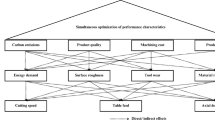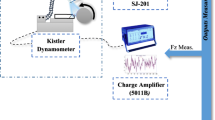Abstract
Metal cutting plays an important role in manufacturing industries. Optimisation of cutting parameters represents a key component in machining process planning. In this paper, a neural network based approach to multiple-objective optimization of cutting parameters is presented. First, the problem of determining the optimum machining parameters is formulated as a multiple-objective optimization problem. Then, neural networks are proposed to represent manufacturers' preference structures. To demonstrate the procedure and performance of the neural network approach, an illustrative example is discussed in detail.
Similar content being viewed by others
Abbreviations
- v :
-
cutting speed (m/min)
- f :
-
feed rate per revolution (mm/rev)
- d :
-
depth of cut per pass (mm)
- T p :
-
total operation time per part (min)
- T i :
-
set-up time per part (min)
- T c :
-
tool change time (min)
- T i :
-
idle time per part (min)
- C p :
-
cost per part ($)
- C t :
-
cost of tool per piece ($)
- C l :
-
labor cost per unit time ($/min)
- C o :
-
overhead per unit time ($/min)
- V :
-
volume to be removed per part (mm3)
- MRR :
-
metal removal rate (mm3/min)
- TL :
-
tool life (min)
- SR :
-
surface roughness (μm)
- H p :
-
arithmetic centre-line average (μm)
- P :
-
cutting power (kW)
- F :
-
cutting force (kg)
- θ:
-
interface temperature (°C)
References
F. W. Taylor, “On the art of cutting metals”,Transactions of ASME,28, pp. 310–350, 1907.
R. H. Philipson and A. Ravindran, “Application of mathematical programming to metal cutting”,Mathematical Programming Study,11, pp. 116–134, 1979.
A. Bhattacharyya, R. Faria-Gonzallez and I. Ham, “Regression analysis for predicting surface finish and its application in the determination of optimum machining conditions”,Journal of Engineering for Industry, Transactions of ASME,92, pp. 711–714, 1970.
D. S. Ermer, “Optimization of the constrained machining economics problem by geometric programming”,Journal of Engineering for Industry, Transactions of ASME,93, pp. 1067–1072, 1971.
D. T. Phillips and C. S. Beightler, “Optimization in tool engineering using geometric programming”,AIIE Transactions,2, pp. 355–360, 1970.
K. Iwata, Y. Murotsu, T. Iwatsubo and S. Fuji, “A probabilistic approach to the determination of the optimum cutting conditions”,Journal of Engineering for Industry, Transactions of ASME,94, pp. 1099–1107, 1972.
S. H. Lee and B. M. Kwak, “Adaptive optimization of factory cutting conditions — a heuristic computer simulation applied to single point tuning”,International Journal of Production Research,19(1), pp. 31–43, 1981.
R. H. Philipson and A. Ravindran, “Application of goal programming to machinability data optimization”,Journal of Mechanical Design, Transactions of ASME,100, pp. 286–291, 1978.
M. R. Ghiassi, E. DeVor, M. I. Dessouky and B. A. Kijowski, “An application of multiple criteria decision making principle for planning machining operations”,IIE Transactions,16(2), pp. 106–114, 1984.
M. Mitwasi, A.-M. Connolly and L. Ducstein, “Applying multiple criteria decision making techniques for planning machining operations”,Applied Mathematics and Computation,29, pp. 197–218, 1989.
B. Malakooti and J. Deviprasad, “An interactive multiple criteria approach for parameter selection in metal cutting”,Operations Research,37(5), pp. 805–818, 1989.
B. Malakooti, “An interactive on-line multi-objective optimization approach with application to metal cutting tuning operation”,International Journal of Production Research,39(3), pp. 575–598, 1991.
S. S. Rangwala and D. A. Dornfeld, “Learning and optimization of machining operations using computing abilities of neural networks”,IEEE Transactions on Systems, Man, and Cybernetics,19(2), pp. 299–314, 1989.
S. S. Rangwala and D. A. Dornfeld, “Senor integration using neural network for intelligent tool condition monitoring”Journal of Engineering for Industry, Transactions of ASME,112, pp. 218–227, 1990.
L. I. Burke and S. S. Rangwala, “Tool condition monitoring in metal cutting: a neural network approach”,Journal of Intelligent Manufacturing,2(5), pp. 269–280, 1991.
B. Malakooti, J. Wang and E. C. Tandler, “A sensor-based accelerated approach for multi-attribute machinability and tool life evaluation”,International Journal of Production Research,28(12), pp. 2373–2392, 1990.
G. M. Hayes and R. P. Davis, “A discrete variable approach to machine parameter optimization”,IIE Transactions,11(2), pp. 155–159, 1979.
M. Shaw,Metal Cutting Principles. Clarendon Press, NY, 1984.
E. Armarego and R. Brown,The Machining of Metal, Prentice-Hall, Englewood Cliffs, NJ, 1969.
S. Hati and S. S. Rao, “Determination of the optimum conditions — deterministic and probabilistic approaches”,Journal of Engineering for Industry, Transactions of ASME,100, pp. 354–359, 1975.
M. Kronnenberg, “Computerized determination and analysis of cost and production rates for machining operations”,Journal of Engineering for Industry. Transactions of ASME,91, pp. 585–596, 1969.
R. L. Keeney and H. Raiffa,Decisions with Multiple Objectives: Preference and Value Tradeoffs. John Wiley & Sons, New York, NY, 1976.
V. Chankong and Y. Y. Haimes,Multiobjective Decision Making: Theory and Methodology, North-Holland, New York, NY, 1983.
D. E. Rumethart, G. E. Hinton and R. J. Williams, “Learning internal representations by error propagation”, inParallel Distributed Processing — Explorations in the Microstructures of Cognition, Vol. 1: Foundations, D. E. Rumelhart, J. L. McClelland, the PDP ResearchGroup (eds), MIT Press, Cambridge, MA, pp. 318–362, 1986.
K. Hornik, M. Stinchcombe and H. White, “Multilayer feedforward networks are universal approximators”,Neural Networks,2(5), pp. 359–366, 1989.
J. Wang and B. Malakooti, “Analysis and synthesis of artificial neural networks for modeling complex systems”,Progress in Neural Networks,2. O. M. Omidvar (ed.), Norwood, New Jersey: Ablex, in press, 1992. Also Technical Report 90-156, Center for Automation and Intelligent Systems Research, Case Western Reserve University Cleveland, Ohio.
J. Wang and B. Malakooti, “A feedforward neural network for multiple criteria decision making”,Computers and Operations Research,19(2), pp. 151–167, 1992.
J. Wang, “Artificial networks versus natural neural networks: a connectionist paradigm for preference assessment”,Decision Support Systems, forthcoming.
J. Wang and M. Bender, “Connectionist decision support systems for multiple criteria decision making”,Proceedings of IEEE International Conference on Systems, Man, and Cybernetics, Charlottesville, VA, pp. 1955–1960, 13–16 October 1991.
Author information
Authors and Affiliations
Rights and permissions
About this article
Cite this article
Wang, J. Multiple-objective optimisation of machining operations based on neural networks. Int J Adv Manuf Technol 8, 235–243 (1993). https://doi.org/10.1007/BF01748633
Accepted:
Issue Date:
DOI: https://doi.org/10.1007/BF01748633




